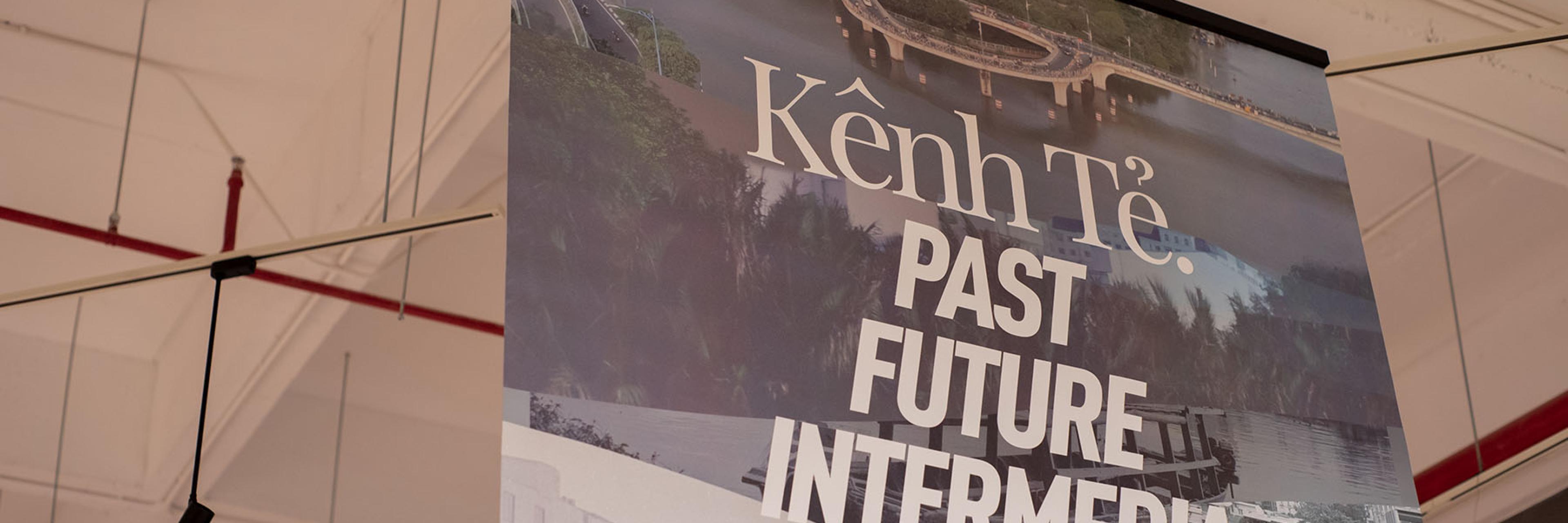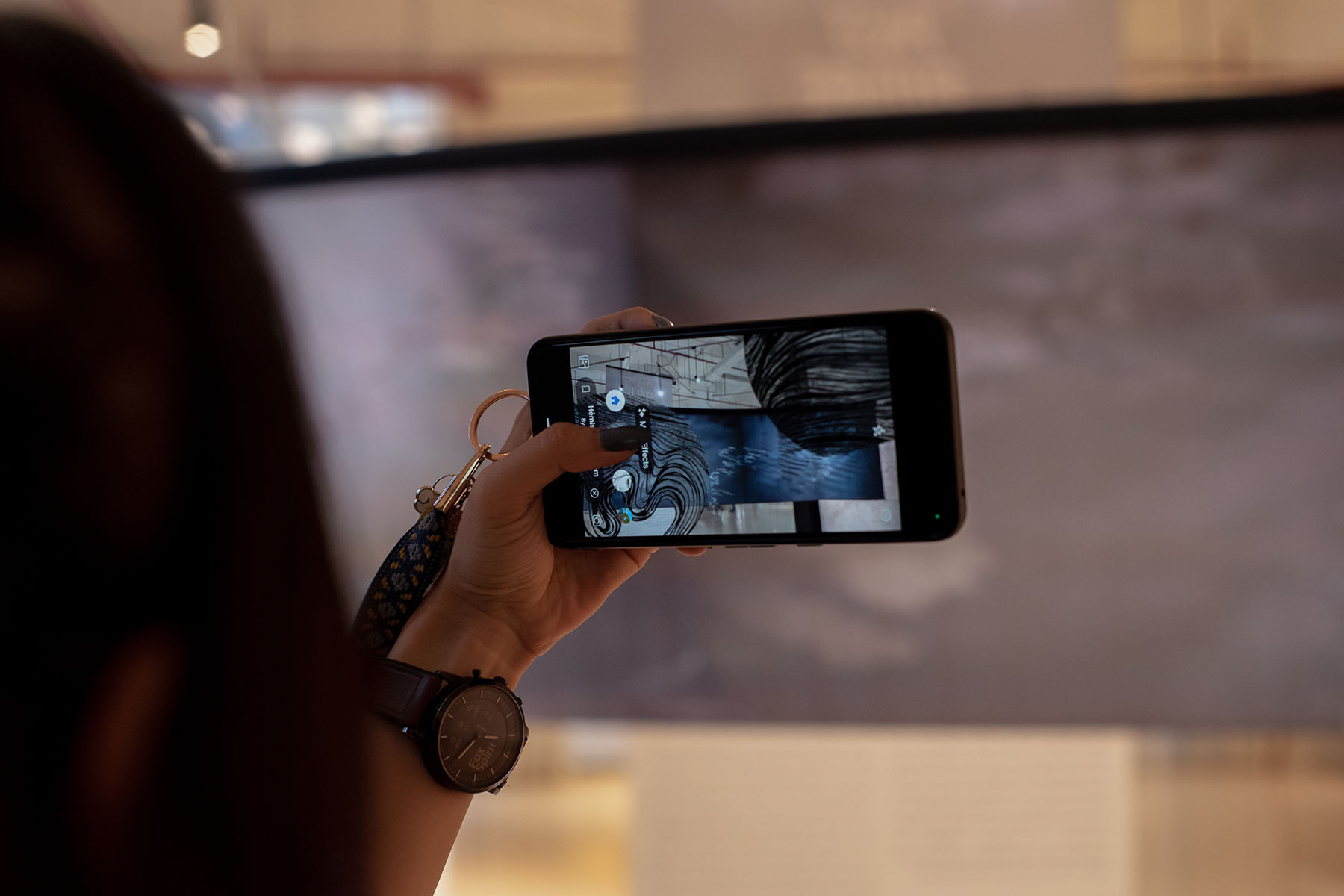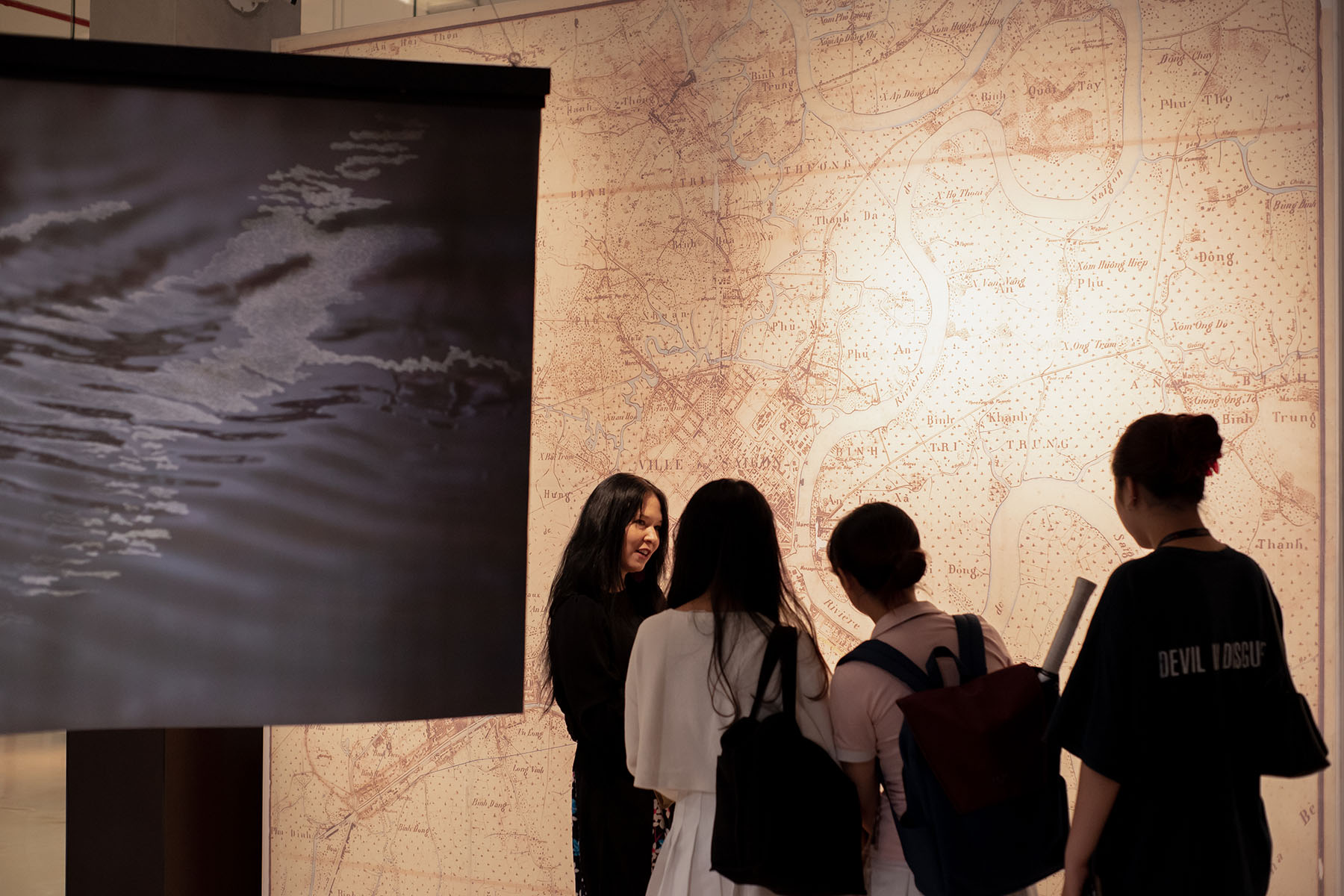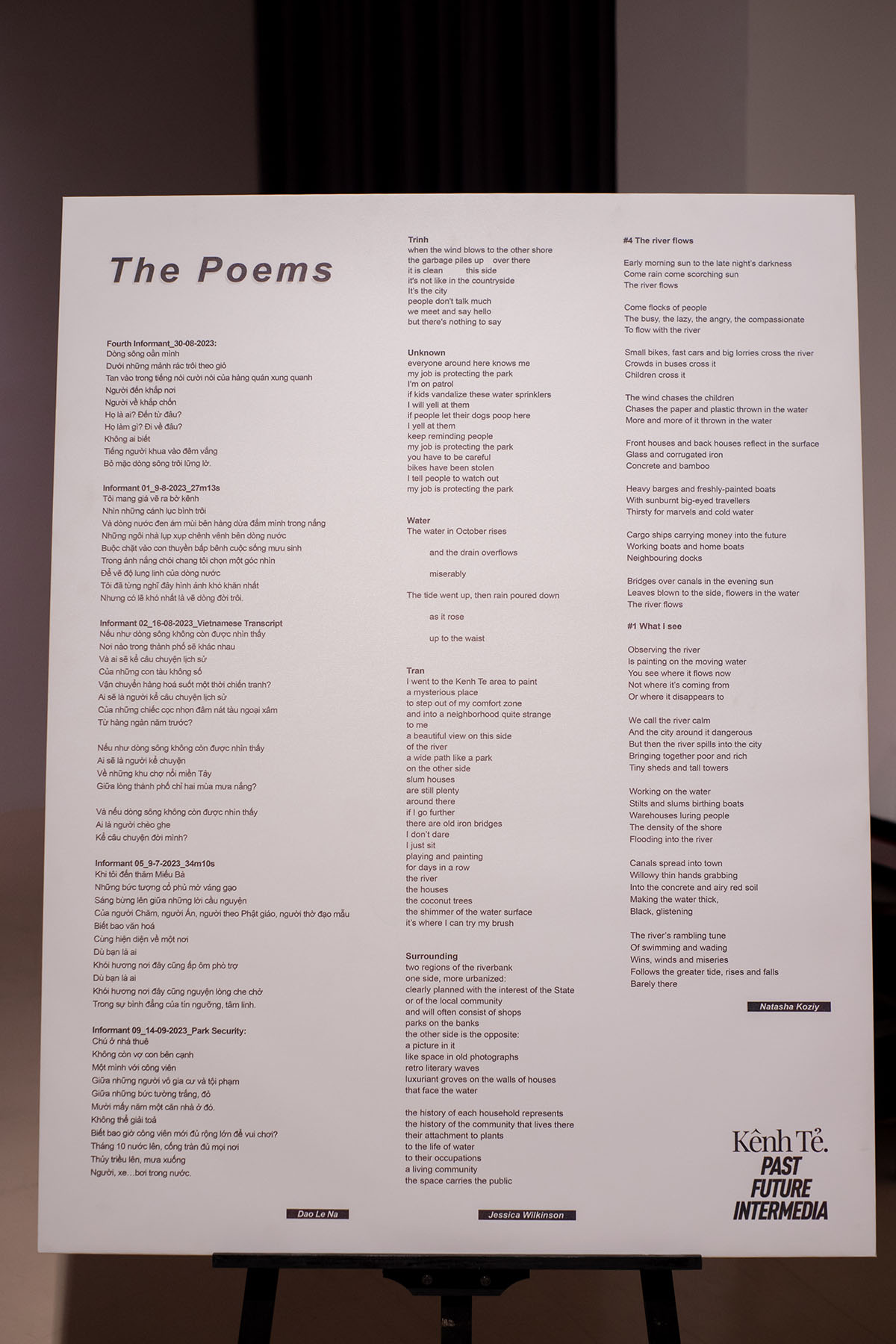
Research Project and exhibition highlight: Kênh Tẻ. Past/Future/Intermedia
The Biography of the Sai Gon River project focused on Kênh Tẻ’s surroundings, capturing the community’s stories to preserve the canal’s current memory. Developed by the researchers from the School of Communication and Design, RMIT Vietnam, within the global River Cities Network, the project created methods for collecting everyday life stories around Kênh Tẻ. It used VR, AR, photography and experimental poetry to design an immersive exhibition, engaging local and international audiences and challenging the notions of heritage in Vietnam. The exhibition designers wanted to show that everyday spaces, like Kênh Tẻ, are crucial to understanding the development and history of the city.
By Agnieszka Kiejziewicz (29 October 2024).
Ho Chi Minh City has a unique and lasting relationship to water. The city's existence is founded on the waterways and subsequent canals that were built to turn the city into a global trade port. The Kenh Tẻ (Tẻ canal) was constructed in the early 20th century to relieve barge congestion on the Ben Nghe canal. This canal has suffered the same fate as many of the city’s waterways, becoming polluted and unloved. But the Kenh Tẻ has developed its own cultural attributes, a close community, a floating market, and a fascinating urban environment.
Analyzing the historical maps of Ho Chi Minh City and archival resources, which inspired the structure and objectives of our project, shows that the canals and adjacent communal areas have been the subject of discussion about modernization and urbanscape since colonial times. Gathered historical documents illuminate the colonial urban project of 1906, now shaping the landscape of Districts 4 and 7 in Ho Chi Minh City. The colonial project's objective was annexing the Khanh Hoi village into Saigon’s municipality. The documentation of the process underlines the struggle of the local residents to maintain their territorial integrity amidst the urban evolution of Saigon. The proposed integration of Khanh Hoi and Chanh Hung into Saigon laid the groundwork for the 'canal de dérivation,' now recognized as the Kênh Tẻ. We can follow urban transformation by analyzing the negotiations and debates, from land disputes to transportation and housing concerns, especially underlining the incongruent shape of traditional wooden architecture and the more modernized cityscape.
The project Biography of the Sai Gon River, finished in June 2024, focused specifically on Kênh Tẻ’s surroundings and featured the stories of the area’s community, preserving the memory of the current state of the canal. The project was developed as a component of the RMIT Vietnam team in the global River Cities Network. The research tasks involved creating and evaluating a method for collecting and utilizing stories about daily life around the Kênh Tẻ. Recognizing the potential of new media communication, the team applied Virtual Reality (VR) technology, AR (augmented reality) and experimental poetry to create an immersive exhibition of history and locality aimed at local and international viewers.
The two-week exhibition, hosted by a local Lotus Gallery, presented aspects of life on and around the Kênh Tẻ. The chosen communication mediums – VR, AR, photography, and experimental poetry – are different but closely related through their ability to reconstruct reality, which can be experienced multiple times and in multiple configurations. The presented works questioned our understanding of heritage. We argued that the unexceptional spaces of the Kênh Tẻ environment are critically important to understanding the heritage and history of the more expansive city. Positioning the everyday as heritage changes our perception that heritage is only found in objects and very old infrastructures.

AR installation. A woman scanning augmented reality installation with a smartphone.
Kênh Tẻ. Past/Future: Virtual Reality (VR) experience
Preserving the unique mood of the Kênh Tẻ and the life around it became the core idea behind the 6-minute virtual experience. Entering the digital, immersive space, the viewer can experience non-touristic areas of Ho Chi Minh City and listen to the stories intangibly connected to the space. The virtual character of the experience, connected with the material component, engages the senses in the spectacle of remembrance and historical reproduction. VR films, established by building the audience’s emotional involvement through participation in in-depth observation, support the learning process designed to focus on the correlations between cognition and empathy-building mechanisms.
This digital work focuses on exploring the possibilities of the VR documentary-making process and the creative application of primary research data. The research process behind the VR experience included action research methodology, designed as 3-stage interviews-based activity. This part of the project was developed by Dr Agnieszka Kiejziewicz.
The film in 360̊ can be watched here: https://www.youtube.com/watch?v=cCIeKYRPcwg&t=33s

Map of Kenh Te. A group of four people standing in front of the big historical map of Saigon.
Sống Xa Ở Gần: Augmented Reality (AR) Installations
Sống Xa Ở Gần explores the everyday of life on and around the Kênh Tẻ. The AR installations reveal the small details discovered by the creatives and portray them as objects that represent the moments of transition, from private life, rituals, and habits to public display. The AR’s celebrate life in Districts 4 and 7 sides of the canal, working with shop fronts, sensory representations of the atmosphere, the future, and the unexceptional heritages of canal and residents. The Kênh Tẻ canal was built in the early 20th century. It split the village of Khanh Hoi in two. One half became District 4, and the remainder is located in District 7. The AR installations are meant to be viewed from both sides overlooking the canal. This acknowledges the bond between them and the shared culture of the unexceptional spaces of Ho Chi Minh City.
This part of the project was developed by Becky Lu and Dr Andrew Stiff, in collaboration with alumni from RMIT Design Studies bachelor program.

VR immersive experience. A girl in the VR Oculus Go headset is standing in front of the screen.
History Section
The exhibition’s history section was built from selected resources obtained during Dr Christopher Denis-Delacour's archival research. We highlighted three of the most significant resources at the exhibition. The archive discovery Dossier relatif au rattachement à la Ville de Saigon du village de Khanh Hoi et d'une partie du village de Chanh Hung, province de Cholon années 1906-1909 (folder TDNK 16753, housed within the Cochinchina Government archives) presents Khanh Hoi notables' petition, drawing the historical perspective of the preservation of village's integrity amid the urban transformation. This resource shows the rich history of Khanh Hoi village as it stands against incorporation into Saigon's municipality, questioning the wooden hut and urban organization. The preliminary plans discovered within the archives outlined the proposed integration of Khanh Hoi and Chanh Hung into Saigon, laying the groundwork for the 'canal de dérivation,' now recognized as the Kênh Tẻ. Analyzing this resource, we could witness the demand from the Saigon municipality as the Chief Engineer of the Second District of the Public Works Navigation Service meticulously crafts this pivotal map.
The second exhibited resource, Khanh Hoi's Oxygen and Acetylene Factory banner (Dossier relatif à l'autorisation d'installer une usine pour la préparation de l'oxygène et de l'acetylène dissous à Khanh Hoi année 1910, folder TDNK 20665), highlights further industrial revolution around the area. The establishment of an oxygen and acetylene factory and the intricate processes involved in obtaining the mandatory operational permit through the Commodo/Incommodo procedure shows how the industrial legacy further shaped the area. Uncovering Khanh Hoi area's deep-rooted industrial tradition and its local resilience amidst the forces of urban integration, we could understand how local residents challenged established norms of living and urbanization. The navigation between the intricate negotiations and discussions surrounding urban transformation, from environmental concerns to infrastructural adjustments, reflects the dynamic interplay between progress and preservation. Through the highlighted documents, we can witness the burgeoning demands placed upon Saigon's municipal administration as they grapple with the complexities of industrial expansion encapsulated in the planning of the colonial administration.
However, the most important historical resource, which was also the initial inspiration for the further shape of our project, was the map of the Kênh Tẻ retrieved from Cochinchina Government archives (folder TDNK 16753). The map, reprinted for exhibition purposes in 3,5x3m size, displays the Kênh Tẻ and the changes that the newly created waterway brought to the city.

The selection of experimental poems.
Photography and experimental poetry: creative dissemination of research
Trying to engage the local community to immerse in our research outcomes, we were searching for the possible engagement of different means of communication, thus establishing the dialogue between the researchers and the audience. The exhibition's photo section was created from the visual material gathered during location scouting for the VR film recording and the research team’s impressions gathered during multiple visits to the canal area. The photos were taken using the analog camera (Rolleiflex 3.5T and Nikon S2) and hand-developed by the research assistant, Bùi Hoàng Tú. The photo section was built from glimpses and moments showing the connection between old and new architecture around the canal and featuring the people working around the traditional wooden boats.
Lastly, the exhibition concluded with an experimental poetry section, inspired by the writer Alice Oswald's perfect application of the process of turning interviews into poems in her book Dart. Here, we repeated the process based on our primary research material and created unique impressions by gathering voices and reflections from the locals.

Photography section.
Team:
Agnieszka Kiejziewicz
Andrew Stiff
Becky Lu
Christopher Denis Delacour
Jessica Wilkinson
Đào Lê Na
Bùi Hoàng Tú
Research and organizational help:
Hiếu Trương
An Lê
Natasha Koziy
Partners:
RMIT Viet Nam
Lotus Gallery
Fox Spirit LTD
Saigon Film Photowalk - Travel Agency
Future Eyes
![Enlarged article in French [left side] and Vietnamese [right side]. Title: Avis au Public/Cao Thi. Exhibition descriptions on the right side of the photo.](/sites/default/files/2024-10/dsc03163.jpg)
Khanh Hoi’s Oxygen and Acetylene Factory establishment information.
Exhibition entrance banner. Photo credits: Fox Spirit, 2024 .